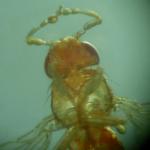In my last post, “The Curious Incident of the Fly in the Night,” I told a story about Mimi Shirasu-Hiza as an example of how scientists sometimes find that—in Shirasu-Hiza’s words—“what might look like ‘noise’ is potentially ‘signal’.’” Noting that her fruit flies were more likely to get sick and die if they were infected at nighttime led her to important discoveries about the effects of circadian rhythm on immune response. Shirasu-Hiza’s work also provides me with a second story, in which, if I may employ another cliché (really bad pun alert), what looked like a bug turned out to be a feature.
Fruit flies have been an important model organism for decades, and many laboratories have discovered or generated mutants with well-characterized phenotypes. (That means that the scientists know which genes in the fly’s genome have been mutated, and they know the effect on the fly’s appearance, behavior, or health.) One of the better-known and more dramatic mutant phenotypes—antennapedia—is pictured below. The antennapedia mutant grows leg-like appendages where its antennae should be. This mutant is an excellent example of how mutations in a single control gene can result in dramatic organismal changes.

If you’d like to look at more fruit fly mutants, check out the exhibit at the Exploratorium (if you live in the San Francisco area) or this on-line version.)
Because of the substantial investment that has been made in this model organism for many decades, when Shirasu-Hiza decided to investigate the connection between circadian rhythm and immune response, she was able to tap into a large network of fruit fly scientists. (That would be scientists who study fruit flies, not fruit flies who are scientists. Just to be clear.) She asked them to send her flies with mutations affecting those two systems. When she started to test the flies, she found that sometimes the same mutant acquired from two different laboratories gave inconsistent results—sort of like if you bought the same make and model of a new Volkswagen (like a Bug....get it?) from two different dealerships and found that the cars got wildly different gas mileages.
What was going on? Was it just a bug—had there been a mix-up in mutants, perhaps? Or was it a previously unrecognized feature of fruit fly biology? Well, you can get a clue from the fact that Shirasu-Hiza gave a talk explaining her discovery at a microbiology conference.
A little background: the field of microbiology has been undergoing a fabulous renaissance in the last twenty years. With the veritable free fall in the cost of DNA sequencing, it has become possible to explore the microbial world to a depth previously unimaginable. And what a world it is: a few decades ago, the number of described bacterial species stood at around 5000. Microbiologists are now debating whether the total will eventually be in the range of 100,000 to 150,000 or one to ten million, or, whether, since microbial genomes are so variable, it is even possible to sort microbes meaningfully into countable species. Part of the challenge is that in addition to rich and diverse microbial ecosystems in soil and water, what is becoming clear is that every single multicellular organism is actually an ecosystem in and of itself—often including microbes that are found nowhere else. From humans to sweetpeas, from corals to, yes, fruit flies, all organisms form interdependent relationships with a few or many bacteria, fungi, and viruses.
Not too long ago, the trillions of microbes that make their home in our guts and on our skins were assumed to be hitchhikers or parasites. Recently, it has become clear that these organisms—collectively known as the microbiome—are extremely important to normal human health and metabolism, with particularly strong links to the immune, endocrine, and digestive systems. When Shirasu-Hiza began to get her inconsistent results, she wondered whether flies from different labs might have brought with them different microbial partners, and that this might be affecting their immune responses. Indeed, when she gave all the flies the same set of microbes, her results became more consistent.
I have just engaged in a huge simplification—the study of microbiomes is as yet in its infancy, and characterizing, manipulating, and monitoring the diverse collection of microbes in any given organism is far from standardized. Shirasu-Hiza’s lab is now undertaking detailed experiments to determine how different populations of microbes affect various aspects of immunity against infection. Like the recognition that circadian rhythms affect immunity, the realization that microbial partners also have a role to play opened up an entirely new avenue of research.
The take-home message is simply this: reproducing Shirasu-Hiza’s results in other laboratories might well have been stymied by differences in fruit flies’ microbiomes—a source of variation that no one would have imagined ten years ago, and that is only now beginning to be widely appreciated. In the rush to ensure that all results are reproducible, it is important to remember that not all sources of variation are known, and non-reproducibility can sometimes be an important source of new insight and discovery.

